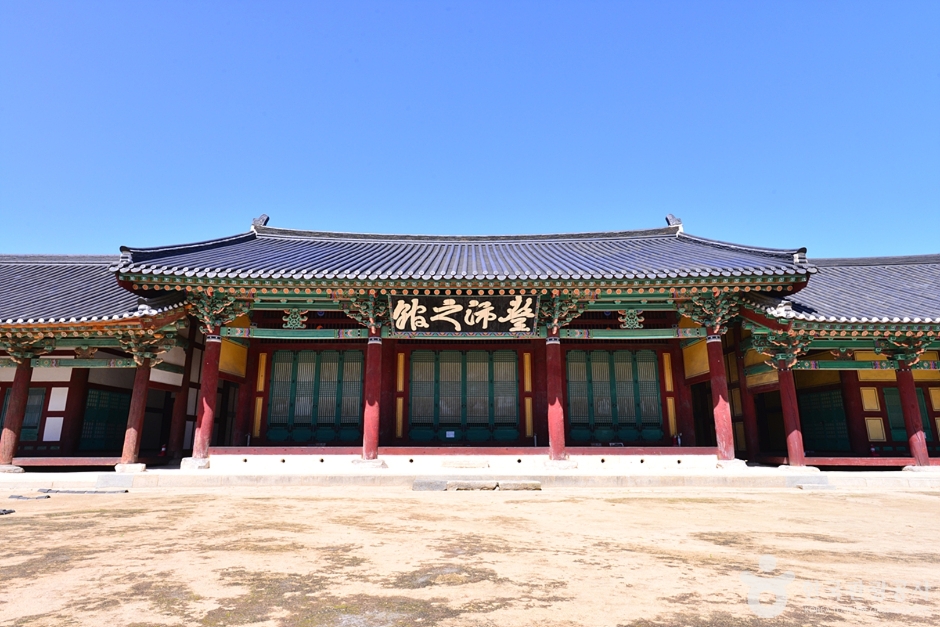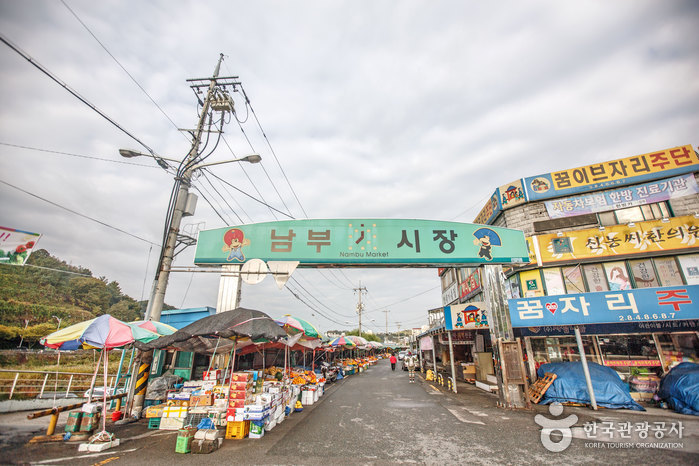Puerta Pungnammun de Jeonju (전주 풍남문)
315.25461500521146m 4539 2024-04-07
Pungnammun 3-gil 1, Wansan-gu, Jeonju-si, Jeonbuk-do.
La puerta Pungnammun se ubica donde estaba la puerta sur de la antigua Fortaleza de Jeonju. Sus primeras construcciones datan de los años 1734 y 1768, y tras ser parcialmente desmantelada por tareas de planificación urbana, finalmente recuperó su forma original en 1978.
Samrockhon [Korea Quality] / 삼락헌 [한국관광 품질인증]
317.59075705564237m 7345 2024-04-07
47-8, Eunhaeng-ro, Wansan-gu, Jeonju-si, Jeonbuk-do
+82-10-7799-7358
Samllakheon is located in the center of Jeonju Hanok Village which is the highlight of traveling in Jeonju. Samllakheon has been opened newly by the owner husband and wife who are running Bugyeongdang, a lodging in traditional Korean style house. The building of Samllakheon used to be the etiquette training center of Jeollabuk-do Province, and its size is much larger and more magnificent than ordinary houses and its style is very antique. The arrangement of the houses, the pillars, rafters, crossbeam and the ridge of the roof are clearly different from those of ordinary houses. The garden covered with pebbles and rocks and the well-tended flower bed are also worth seeing.
The rooms are composed of the five rooms of Spring, Summer, Fall, And, & Winter. Every room has a duplex attic under the high ceiling and a warm and clean restroom. The guests can help themselves with coffee, tea, toast, etc. for breakfast from the communal mini kitchen. The guests of Samllakheon can have 50% discount on Korean traditional clothes and 30% discount on rent of electric bike. It is also possible to experience traditional culture including making Injeolmi rice cake, Korean paper art, pottery and fragrant purse by making a reservation in advance.
The owners of the house can give information on Jeonju Hanok Village, many other tourist attractions and famous restaurants in Jeonju area. Major tourist attractions within walking distance are Jeondong Catholic Church, Gyeonggijeon, Gyodong Art Center, Choi Myung-Hee Literature Center, Omokdae, Jeonju Hyanggyo, Pungnammun Gate nd Nambu Market & Youth Mall.
Siwon [Korea Quality] / 시원 [한국관광 품질인증]
325.49984563964455m 11550 2024-04-07
45-41, Omokdae-gil, Wansan-gu, Jeonju-si, Jeonbuk-do
+82-10-6520-7840
Situated within Jeonju Hanok Village, Siwon is a hanok experience hall designated by the local government. The names of its individual rooms carry such meanings as “a wish for a life full of love, health and joy”. Each room (except the Gadeukbang) has a small attic where guests can have fun climbing up and down a ladder.
The clay structure with a wood shingle roof is the source of many fond memories for the owner, a permanent fixture of the village, who was born and grew up in the house. The house was once called “the house of persimmon trees in Ssangsiam alley”.
Although the framework of the house was completed in 1954, it has only been open to tourists since it was repaired and renovated in 2014. The house has been fully insulated against draughts and sound-proofed, transforming into a comfortable, cozy guest house that retains the unique beauty of a traditional Korean hanok.
The house’s yard contains a small flower garden and a swing, as well as a space where guests can play tuho, a traditional game in which the players try to throw sticks into a canister, jaegichagi, and other traditional games. In addition, guests can try their hand at woodcraft by cutting and carving pieces of wood into artworks of their own making.
A number of attractions are within walking distance of Siwon, including Gyeonggijeon Shrine, which contains the portrait of King Taejo Seong-gye Yi, the founder of the Joseon Dynasty; Jeondong Cathedral, which features a European architectural design; Omokdae, where King Taejo defeated the Japanese army and held a banquet; Jeonjuhyanggyo Local Confucian School; Namcheon Bridge and Cheonyeonru Pavilion; Nambu Market, a foodies’ paradise; and the Youth Mall
Pungpaejigwan de Jeonju (전주 풍패지관 (전주객사))
338.45249443284615m 34178 2024-05-14
Chunggyeong-ro 59, Wansan-gu, Jeonju-si, Jeonbuk-do
Catedral Católica de Jeon-dong en Jeonju (전주전동성당)
367.4958477337629m 6139 2024-04-06
Taejo-ro 51, Wansan-gu, Jeonju-si, Jeonbuk-do.
La Catedral Católica de Jeon-dong fue construida en 1914 al estilo occidental y fue designada como Sitio Histórico. Es la estructura del estilo occidental más grande de las provincias de Jeollanam-do y Jeollabuk-do. La catedral es elegante con sus paredes de ladrillos y lo más encantador es la entrada y la torre de campana. La entrada de la iglesia tiene una forma arqueada que le da un toque bizantino, mientras que la pequeña torre de campana ubicada en el centro agrega una belleza singular. Desafortunadamente, algunas partes de la catedral fueron destruidas por un incendio en 1988.
Jeonju hanok house [Korea Quality] / 전주한옥숙박체험관 [한국관광 품질인증]
390.96648885021705m 1623 2024-04-07
56-1, Eunhaeng-ro, Wansan-gu, Jeonju-si, Jeonbuk-do
+82-10-3659-0055
Jeonjuhanok Korean House is a traditional Korean house built more than 60 years age, and it was recently remodeled for visitors to see and experience an old traditional Korean house. It’s conveniently located on the street called "Eunhaeng-ro" right in the middle of Jeonju Hanok Village for those visiting the area to take a tour of the hanok village. Although it's in the middle of the village, it's quiet inside because it's located at the end of a long, wide alley, which has the feel of an art gallery thanks to the lighting. There is a table in the yard in front of the ‘ㄱ’-shaped house. Behind the house is a café where breakfast is served. The house has an open space between the rooms called "toetmaru", which serves as a living room as in all traditional Korean houses. It’s where Koreans used to rest under the warm sunlight in the old days. The guests must pass through this "toetmaru" to get to the roms.
Jeonjuhanok Korean House has seven "ondol (floor-heated)” rooms with a loft. The rooms are clean and have a simple interior with a wooden ladder to the loft, which is a favorite place for most kids staying here with their parents. Each guestroom is furnished with a water purifier. The guesthouse serves toast, caffe Americano, fruits, and tea for breakfast.
Mercado Nambu de Jeonju (전주 남부시장)
414.8165590289273m 16960 2024-04-06
Pungnammun 1-gil 19-3, Wansan-gu, Jeonju-si, Jeonbuk-do
Establecido en 1905, el Mercado Nambu de Jeonju es hasta la actualidad un importante punto de comercio, de economía y de transporte para los habitantes de la ciudad de Jeonju. Desde finales de los 60 hasta los años 70, el precio del arroz en general se determinaba en este mercado, mostrando así su gran influencia en los mercados de Corea. Actualmente, unas 800 tiendas se encuentran en el predio. Todos los viernes y sábados hay un mercado nocturno donde se pueden probar platos para picar como morcillas, tortitas y rollitos.
Ilrakdang sarangchae [Korea Quality] / 일락당사랑채 [한국관광 품질인증]
414.9526156107487m 2872 2024-04-07
15, Choemyeonghui-gil, Wansan-gu, Jeonju-si, Jeonbuk-do
+82-10-3084-6679
A must visit place for tourists in Jeonju, Ilrakdang Sarangchae is located in the middle of the traditional Korean house village of Jeonju. The very first of three enjoyments for noble man, as indicated by Menicus, the existence of parents and brothers with no troubles is what the place is named after. Standing in the garden, you can easily see the stone walls of Gyeonggijeon and also you are within the range of walking distance to Jeondong catholic church, Omokdae, Southern market, Jeonju Hyanggyo, and the wall painting village of Jaman.
The rooms are called, Haengbokchae, Sarangbang, Mitum band, Monday, Tuesday, Wednesday, Thursday, Friday, Saturday, Sunday and so on. Haengbok room 1/2, a living room with furnace, a big sized attic above the living room are shared together, which makes it most suitable for big families or a small group of tourists. The Monday/Tuesday/Friday/Saturday/Sunday rooms all have a small, cozy attic and in every guest room’s wall, column and doors are mainly made of woods which makes them feel very warm. On every morning, in the shared kitchen, simple breakfasts mainly consisting of toasts, jams, coffee and juice are served. All guests are provided with discounts on Korean costume rental(30%), motor bikes(30%) and waengi bean sprout soup with rice (1000KRW). Besides, there are various services such as introduction to tasty restaurants in partnerships with traditional Korean house villages, as well as discounts, and try out of Korean rice cake making experiences and so on.
Calle Gaeksa-gil (객사길)
420.30965116621906m 0 2024-04-06
Jungang-dong 2-ga 10-1, Wansan-gu, Jeonju-si, Jeonbuk-do
Dong Nak Won [Korea Quality] / 동락원 [한국관광 품질인증]
424.5516605389143m 219 2024-04-07
33-6, Eunhaeng-ro, Wansan-gu, Jeonju-si, Jeonbuk-do
+82-63-287-9300
Hanok Hotel Dongrakwon used to be a memorial hall for Missionary M. Junkin who worked in Jeonju in 1985, and had long been used as an official residence for the Bank of Korea. The 100-year-old Hanok retains the history and culture that modern hotels do not have. Since the renovation to make it a hanok hotel, it is now utilized as a space for traditional music performances, traditional weddings, or small weddings. The entire building can be rented for various gatherings, seminars, conferences, family events, and so on. The beauty of a hanok is found in every corner of Dongrakwon such as the wide lawn, the pond in front of Sarangchae, and the jar stand next to Anchae. The antique furniture and folding screen in the rooms have been used for generations, enabling guests of the hanok to time travel to 50-100 years ago.
The yard is a great place to play simple Korean traditional plays such as Jegichagi and Dakjichiji, whereas the free-of-charge red clay sauna will relieve fatigue. The outdoor hot / cold bath and sun bath site is a new addition to Dongrakwon.
There is a 600-year-old Ginkgo tree standing on the Eunhang-ro, where the accommodation is located. Opposite the alley is Donghak Revolution Memorial Exhibition Hall; Gyeonggijeon East Gate is 200m away. The hotel is close to Taejo-ro, the busiest street of Jeonju Hanok Village; neighboring Eunhang-ro, Choi Myeong Hee-gil, and Eojin-gil all retain the unique quietness and beauty of Hanok Village. It will be also nice to ride on the mountain bike that Dongrakwon offers free of charge in order for guests to visit corners of the Hanok Village, or ride along the Jeonjucheon Stream.

![Samrockhon [Korea Quality] / 삼락헌 [한국관광 품질인증]](http://tong.visitkorea.or.kr/cms/resource/02/2596602_image2_1.jpg)
![Siwon [Korea Quality] / 시원 [한국관광 품질인증]](http://tong.visitkorea.or.kr/cms/resource/24/2596624_image2_1.jpg)


![Jeonju hanok house [Korea Quality] / 전주한옥숙박체험관 [한국관광 품질인증]](http://tong.visitkorea.or.kr/cms/resource/90/2531490_image2_1.jpg)

![Ilrakdang sarangchae [Korea Quality] / 일락당사랑채 [한국관광 품질인증]](http://tong.visitkorea.or.kr/cms/resource/57/2596657_image2_1.jpg)

![Dong Nak Won [Korea Quality] / 동락원 [한국관광 품질인증]](http://tong.visitkorea.or.kr/cms/resource/16/2595016_image2_1.jpg)
 Español
Español
 한국어
한국어 English
English 日本語
日本語 中文(简体)
中文(简体) Deutsch
Deutsch Français
Français Русский
Русский